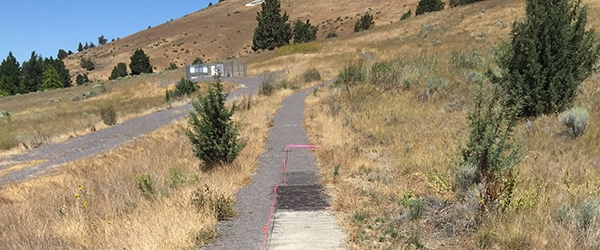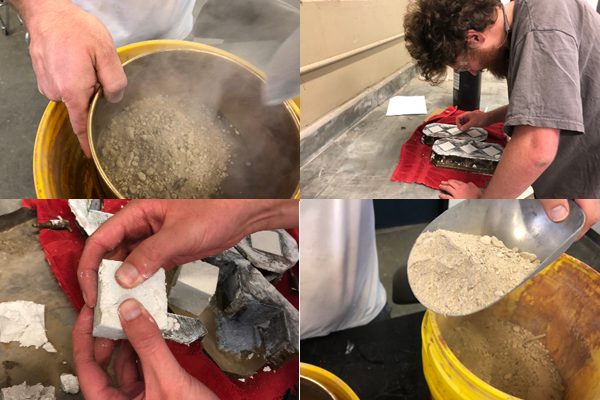Mount Mazama Ash Offers Sustainable Solution for ADA Accessibility on Unpaved Trails

Approximately 7,700 years ago—in a cataclysmic event which the Klamath people retold and passed down for over 300 generations—Mount Mazama erupted, forming Crater Lake in Oregon. With molten rock reaching temperatures of up to 2,200 degrees Fahrenheit, complex chemical reactions ensued. The resulting Mazama ash holds some properties that are similar to those in portland cement.
Today, most construction projects use portland cement, which takes an excessive amount of energy to create. Materials are mined from several different sources and transported, then heated to thousands of degrees for a long time. Anything made with portland cement inherently has very high embodied energy. Meanwhile, orange-colored deposits of Mazama ash are plentiful throughout southern Oregon and much of the Pacific Northwest, and have been identified as far northeast as the Greenland ice sheet.
National Institute for Transportation and Communities (NITC) researcher Matthew Sleep of Oregon Tech investigated whether Mazama ash could be used in place of portland cement, as a natural pozzolan. Results indicate that it can—and unpaved trail surfaces made with Mazama ash are actually firmer and more durable than those made with portland cement alone. Such trails can provide a reliable surface for wheeled mobility devices.
IMPACT ON ADA ACCESSIBILITY IN NATURAL AREAS
"Creating ADA accessible trails is really beneficial for the third pillar of sustainability, which is equity and access: for everybody to be able to utilize the infrastructure," Sleep said. (In a commonly used framework, Environmental Protection and Economic Viability are the first two pillars of sustainability and Social Equity is the third.)
The Americans with Disabilities Act (ADA) provides specific requirements for unpaved trails: the surface must be "firm, stable and slip resistant." Using unpaved trails in natural areas has important environmental benefits, such as increased permeability for rain. So a trail surface that is both unpaved and also ADA-compliant is ideal for keeping parks and other natural areas healthy while making them accessible to everyone.
Some compacted aggregate materials may meet ADA requirements initially, but degrade over time. With Mazama volcanic ash applied topically to unpaved trails, the surfaces are firmer and continue to gain strength for a much longer time than trails made with portland cement alone.
More recreational areas and trails will be subject to accessibility requirements in the future, and Sleep’s work offers a sustainable option for the people who develop and maintain national and state parks and other natural areas.
LAB AND FIELD TESTING
Sleep's team at Oregon Tech conducted an extensive laboratory and field study to determine the effectiveness of using volcanic ash to increase the firmness and stability of unpaved trail surfaces. Volcanic ash was obtained from Klamath County, Oregon, and processed with a commercial rock crusher to make it fine enough for use as a natural pozzolan. Mortar cubes created with volcanic ash showed appreciable gains in strength between 28 and 84 days of curing. A lab-scale testing device was constructed with adjustable confinement to refine the process of applying the topical mix. The team did field-scale testing with 12 lots of applied treatment testing different mixes.
"We showed long-term strength gains with this material that don't happen when you just use portland cement. Portland cement doesn't gain strength after about 28 days, and so far we've continued to see strength gains up to 84 days," Sleep said.

Oregon Tech grad student Damian Matzen (Meet Damian) working with Mazama ash
NEXT STEPS FOR MAZAMA ASH AS A NATURAL POZZOLAN
"Everybody is aware of natural pozzolans, but for whatever reason, it has not really caught on in the industry," Sleep said. So what needs to happen to help it catch on?
Mainly, it's a question of scale. Everything the researchers at Oregon Tech have done so far has been small-scale, with testing on small samples and in controlled environments. With the cooperation of more professionals in the materials and construction industry, it would be possible to do this type of testing – and eventually start using the ash as a proven material – on a more commercial scale.
To help raise awareness of the benefits of Mazama ash and its widespread availability, especially in the Pacific Northwest, Sleep will share his research findings in a webinar on May 19.
Learn More: Register for the May 19 webinar
Sleep and his research team have been in contact with pumice producers in northern Klamath county, who are already mining Mazama ash for pumice and are interested in the possibility of another potential use for the material.
"Using volcanic ash – any natural replacement for portland cement – has a huge environmental impact. We did some research using a sustainability tool from Virginia Tech and found both that embodied energy and CO emissions are significantly less, anytime you can replace portland cement with volcanic ash," Sleep said.
This report is a continuation of work started with a NITC Small Starts grant in 2018. This work furthers the U.S. DOT's goal of continuously modernizing and improving safe, sustainable infrastructure for the traveling public.
This research was funded by the National Institute for Transportation and Communities, with additional support from the Oregon Institute of Technology.
RELATED RESEARCH
To learn more about this and other NITC research, sign up for our monthly research newsletter.
- The Use of Mt. Mazama Volcanic Ash as Natural Pozzolans for Sustainable Soil and Unpaved Road Improvement
- Durability Assessment of Recycled Concrete Aggregates for use in New Concrete
- The Connection between Investments in Bus Stops, Ridership, and ADA Accessibility
The National Institute for Transportation and Communities (NITC) is one of seven U.S. Department of Transportation national university transportation centers. NITC is a program of the Transportation Research and Education Center (TREC) at Portland State University. This PSU-led research partnership also includes the Oregon Institute of Technology, University of Arizona, University of Oregon, University of Texas at Arlington and University of Utah. We pursue our theme — improving mobility of people and goods to build strong communities — through research, education and technology transfer.
